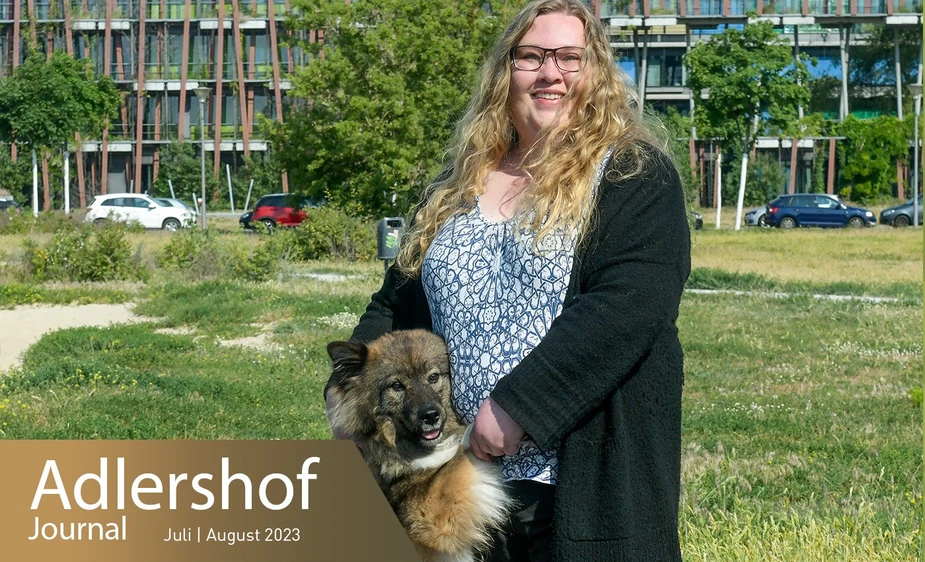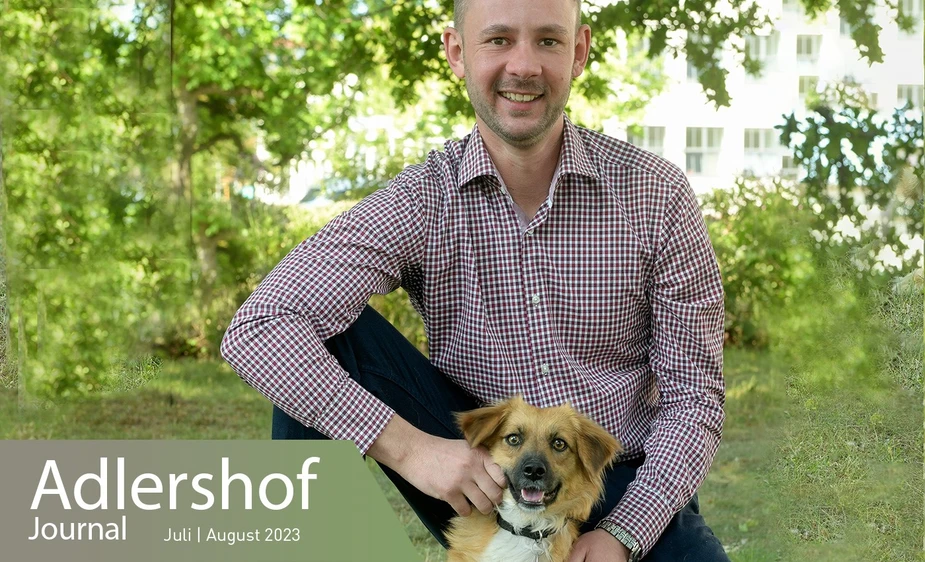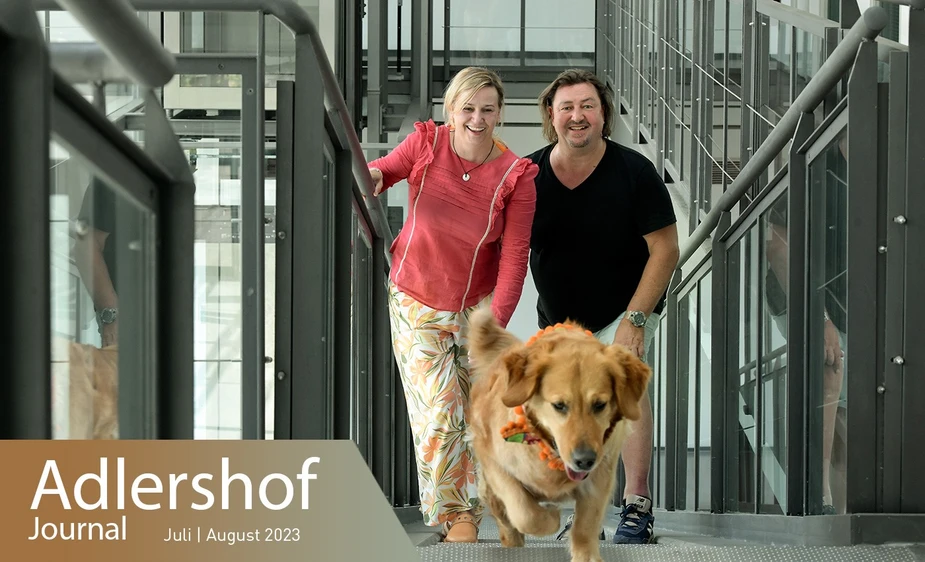Stress reliever or source?
How animals in the workplace can reduce stress and increase productivity if clear rules are in place
Animals in the workplace? A controversial issue to say the least. In fact, animals at the office, dogs especially, can reduce stress and increase productivity. However, a brief survey of dog owners on campus has shown that this can only work with clear rules in place.
Mina is a real “teddy bear”. At least that’s what Karin Neugebauer calls her dog. Her nickname is no coincidence. Mina is an Elo, a crossbreed, blessed with thick fluffy fur that begs to be cuddled. The Elo breed is generally viewed as a relaxed but energetic family dog. One could add “and an excellent office dog” if this were an overall more common phenomenon. Many of the staff at Forschungsverbund Berlin e. V., the research association where Neugebauer works as a human resources administrator, love Mina. They love her, too, because she is well-behaved. The dog dashes to her spot obediently as soon as the office door opens, never barks, but enjoys being cuddled. “I love my dog, but I was strict raising her,” says Neugebauer with emphasis.
This, too, was no coincidence. Neugebauer was 13 years old when she got her first four-legged friend. “I was responsible for my German shepherd from day one,” she says. “Since then, I could not imagine a life without a dog.”
And so, Mina, who is now three and a half years old, was the next dog to become the centre of Neugebauer’s everyday life. “For me, having a dog that spends most of the day alone at home while I work is out of the question.” But not every office door is open to the animal world. At Forschungsverbund Berlin, too, there was not a consistent policy in place at first. And along came Mina. Neugebauer simply asked management whether she could bring her furry companion to work. They reacted by conducting a survey to take the temperature among staff. Finally, a “dog agreement” was drawn up that stipulated what was possible and what was not.
Possible: Up to three dogs on three days a week but not more than one animal per office room. It’s ok to bring a four-legged friend to internal meetings but at external meetings, it’s “no dogs allowed”. Not possible: unhealthy, unvaccinated, uninsured dogs. Also not possible: playing with the dog while on the clock, bringing it into kitchens and common rooms, using office dishes for the animal, and walking the hallways without a leash. Large or dangerous dogs are not permitted – as well as those who do not know how to behave. Finally: no wet dogs. “When it rains, Mina stays at home because damp fur tends to be quite fragrant,” says Neugebauer. “It's also important to communicate extensively with colleagues about what's ok for them or what bothers them.” Neugebauer has not heard anything negative so far. Mina and her (and her colleagues) are now a finely tuned team.
This also applies to Aly and Martin Rozinski. The latter is responsible for managing properties at WISTA Plan GmbH. The former, Aly, is a two-year-old mixed-breed dog with a steep learning curve behind her. She has been living with Rozinski since early April. The animal spent half of her life on the streets of Belarusian cities before an animal welfare organisation took her in and arranged the adoption by Rozinski. “First, she had to be trained – and learn German, so to speak,” he says.
This worked well and fast and Aly became a well-behaved and also well-off office darling almost immediately. “She is sweet, docile, and a welcome change of routine in the day-to-day work. Aly is a proper feel-good factor,” says Rozinski. She accompanies him four days a week, even to outside appointments. Needless to say, these are particularly interesting to her. Nothing beats going for a walk. However, this arrangement also means that Aly does not appreciate having to go back to the office, or worse, the flat. By now, not only the dog but Rozinski, too, is only greeted with “Hey, Aly”. This is successful coexistence. It worked because the people sitting right next to Rozinski and his other co-workers were asked how they feel about a furry companion and about their fears and concerns.
This is also the way Anja Nienbarg and Stefan Bloschies dealt with the issue, although they are not employees but the CEOs at zielgruppe kreativ Gesellschaft für Marketing und Kommunikation mbH, a marketing company. “Being the bosses, we didn’t want to just ‘force’ the dog on our staff,” they say, “we were aware that not all our colleagues are necessarily huge dog enthusiasts.” Some of them were passionate runners who had a somewhat tense relationship with off-leash dogs due to past negative experiences. Nobody has a problem with Paula, the couple’s Golden Retriever. “She has a relaxed and quiet personality but is always very energetic,” says Bloschies. Whenever she sees one, she goes bananas and will not stop playing ever ...” If the dog finds a human playmate to share this with, her joy is perfect.
However, there is no frolicking at the office: Paula simply potters around, minding her own business. She particularly enjoys lying under tables. Nienbarg: “The way we experience it is that her presence makes everyday life a lot more pleasant and relaxed – both for us, for the vast majority of employees, and herself!" Paula is at the agency an average of two to three days per week. She can be a real icebreaker, facilitating and fostering understanding and social exchange among employees. Paula radiates calm and has a soothing effect on humans because of it,” says Bloschies. “This is especially important during stressful appointments or difficult conversations.” People simply spend a few moments with the animal, watch it play, and forget the hustle and bustle for a brief moment. “This also goes for clients who come to see us at the agency,” says Nienbarg.
Indeed, there is something therapeutic about an animal’s presence. “Cuddling reduces stress hormones,” says Neugebauer, quoting a study. In reality, however, nobody needs a study to prove what is clearly felt by her and her colleagues every day. “There is no question that an animal enriches our everyday life, inside and outside the office, and creates a pleasant environment,” says Karin Neugebauer.
Chris Löwer, Adlershof Journal


